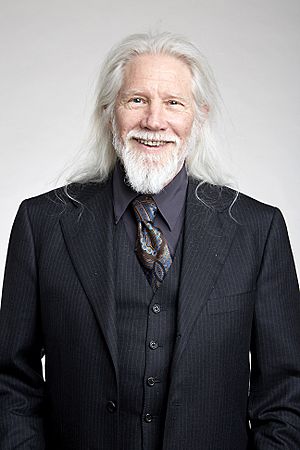Whitfield Diffie facts for kids
Quick facts for kids
Whitfield Diffie
|
|
|---|---|

Whitfield Diffie at the Royal Society admissions day in London, July 2017
|
|
| Born |
Bailey Whitfield Diffie
June 5, 1944 Washington, D.C., U.S.
|
| Education | Massachusetts Institute of Technology (BS) |
| Known for | Diffie–Hellman key exchange |
| Awards |
|
| Scientific career | |
| Fields | Cryptography |
| Institutions | Stanford University Sun Microsystems ICANN Zhejiang University Royal Holloway (ISG) |
Bailey Whitfield 'Whit' Diffie is an American cryptographer and mathematician. He was born on June 5, 1944. He is known as one of the people who helped create public-key cryptography. This is a very important way to keep information secret and safe online.
In 1976, Diffie and his partner, Martin Hellman, wrote a famous paper. It was called New Directions in Cryptography. This paper introduced a new way to share secret codes, called "keys." This method is now known as the Diffie–Hellman key exchange. It changed how we protect information on the internet today.
After working at Sun Microsystems for a long time, Diffie also worked for ICANN. ICANN is a group that helps manage the internet. He was their Vice President for Information Security and Cryptography. He has also been a scholar at Stanford University.
Contents
Early Life and Education
Whitfield Diffie was born in Washington, D.C.. His mother, Justine Louise, was a writer. His father, Bailey W. Diffie, taught history. Whitfield became interested in secret codes when he was about 10 years old. His father brought home many books about cryptography from the library.
Diffie went to Jamaica High School in Queens, New York. He was good at school but did not always try his hardest. He got into the Massachusetts Institute of Technology (MIT) because he scored very high on tests.
At MIT, he started learning how to program computers. He earned a Bachelor of Science degree in mathematics from MIT in 1965.
Career and Research
After college, Diffie worked as a research assistant for the MITRE Corporation. He helped create computer programs that were not for military use. This job also helped him avoid being drafted into the army during the Vietnam War.
In 1969, Diffie became a programmer at the Stanford Artificial Intelligence Laboratory. There, he became very interested in cryptography and computer security.
In 1973, Diffie left Stanford to do his own research on cryptography. At that time, most secret code research was kept secret by the government. Diffie traveled around, looking for rare books and talking to friends at universities.
Meeting Martin Hellman
In 1974, Diffie met Martin Hellman, a professor at Stanford University. Hellman was also working on cryptography. They talked for many hours and shared their ideas. Hellman then hired Diffie to work in his lab.
Diffie and Hellman worked together on a big problem. They criticized the government's proposed Data Encryption Standard (DES). They thought its secret code length was too short. They believed it could be easily broken by powerful computers. History later showed they were right.
From 1978 to 1991, Diffie worked for Northern Telecom. He designed security systems for computer networks.
In 1991, he joined Sun Microsystems. He worked on how cryptography could be used in public policy. He stayed at Sun until 2009, becoming a chief security officer.
Diffie also taught as a visiting professor at Royal Holloway, University of London. In 2010, he joined ICANN as a vice president. He left that role in 2012.
More recently, in 2018, he became a visiting professor at Zhejiang University in China.
Public Key Cryptography
In the early 1970s, Diffie and Martin Hellman developed the main ideas for public-key cryptography. They published their findings in 1976. This was a huge step forward in cryptography.
Before their work, governments mostly controlled secret coding technology. Diffie and Hellman's ideas changed that. Their work made it possible for companies and regular people to use strong encryption. This meant everyone could protect their private information. Their solution is known as the Diffie–Hellman key exchange.
Publications
- Privacy on the Line (1998) with Susan Landau.
- New directions in cryptography (1976) with Martin Hellman.
Awards and Honors
Whitfield Diffie and Martin Hellman won the 2015 Turing Award. This is one of the most important awards in computer science. They received it for their "fundamental contributions to modern cryptography." Their 1976 paper introduced public-key cryptography and digital signatures. These ideas are now the basis for most security on the internet.
Diffie has received many other awards and honors:
- An honorary doctorate from the Swiss Federal Institute of Technology Zürich (1992).
- The IEEE Donald G. Fink Prize Paper Award (1981).
- The Louis E. Levy Medal from The Franklin Institute (1997).
- The IEEE Richard W. Hamming Medal (2010).
- He was inducted into the National Inventors Hall of Fame (2011).
- He was named a Fellow of the Computer History Museum (2011).
- He became a Foreign Member of the Royal Society (2017).
- He was elected a member of the National Academy of Engineering (2017).
Personal Life
Diffie sees himself as an "iconoclast." This means he likes to challenge traditional ideas. He has said that he cares a lot about the privacy of individuals. He believes people should have privacy, not just governments keeping secrets.
See also
 In Spanish: Whitfield Diffie para niños
In Spanish: Whitfield Diffie para niños


